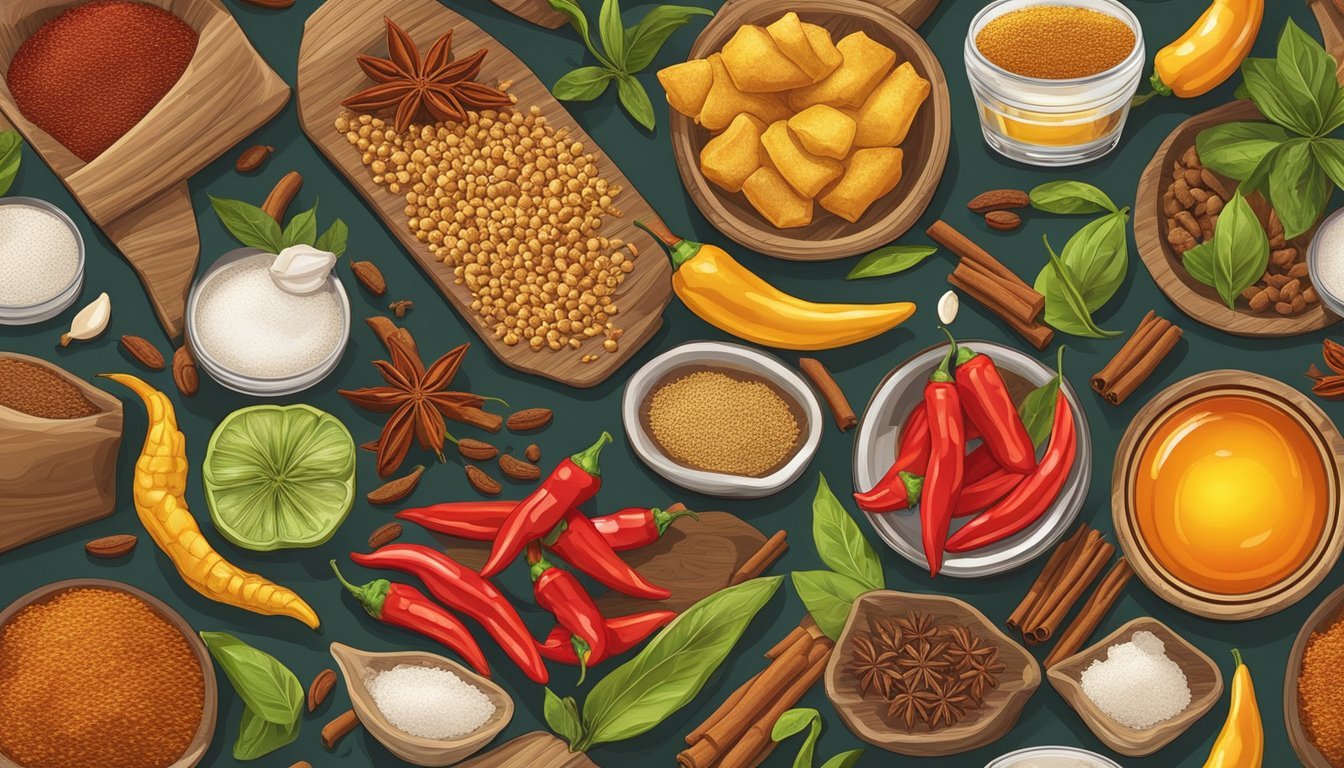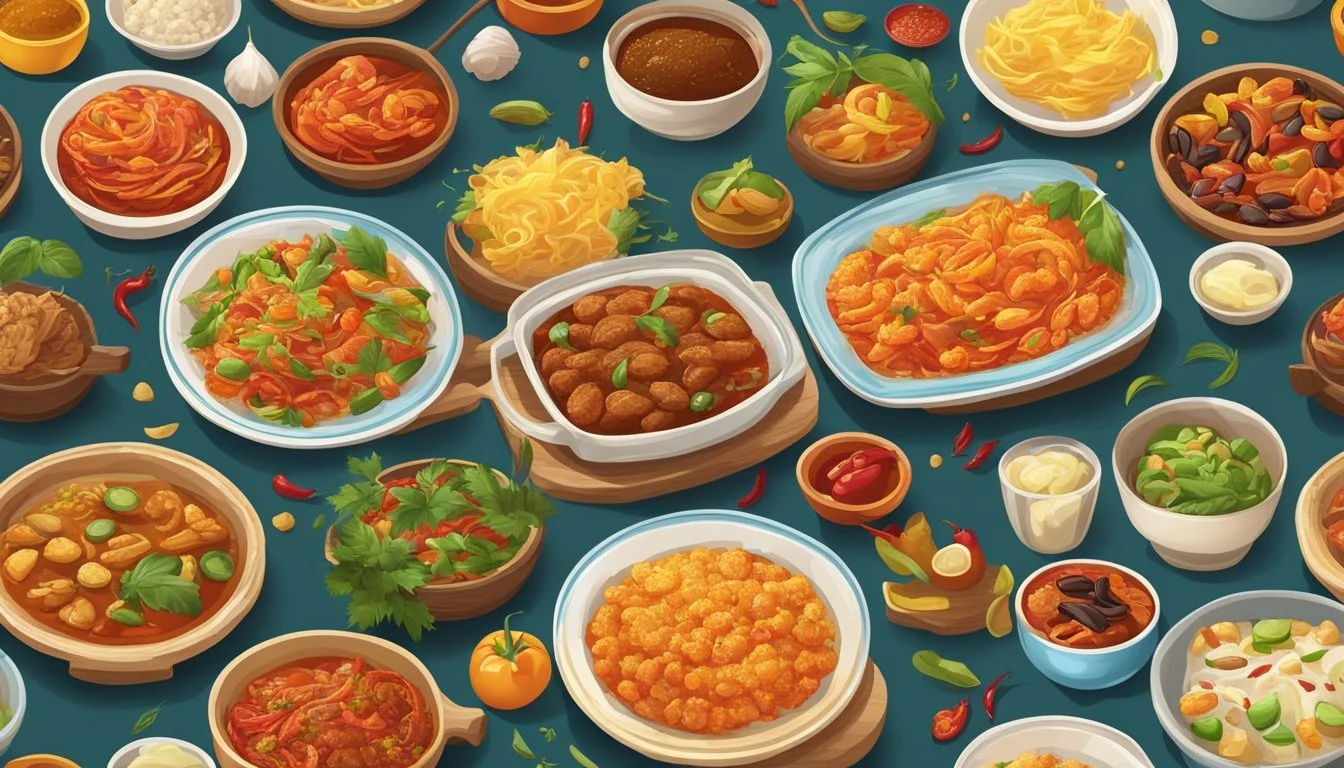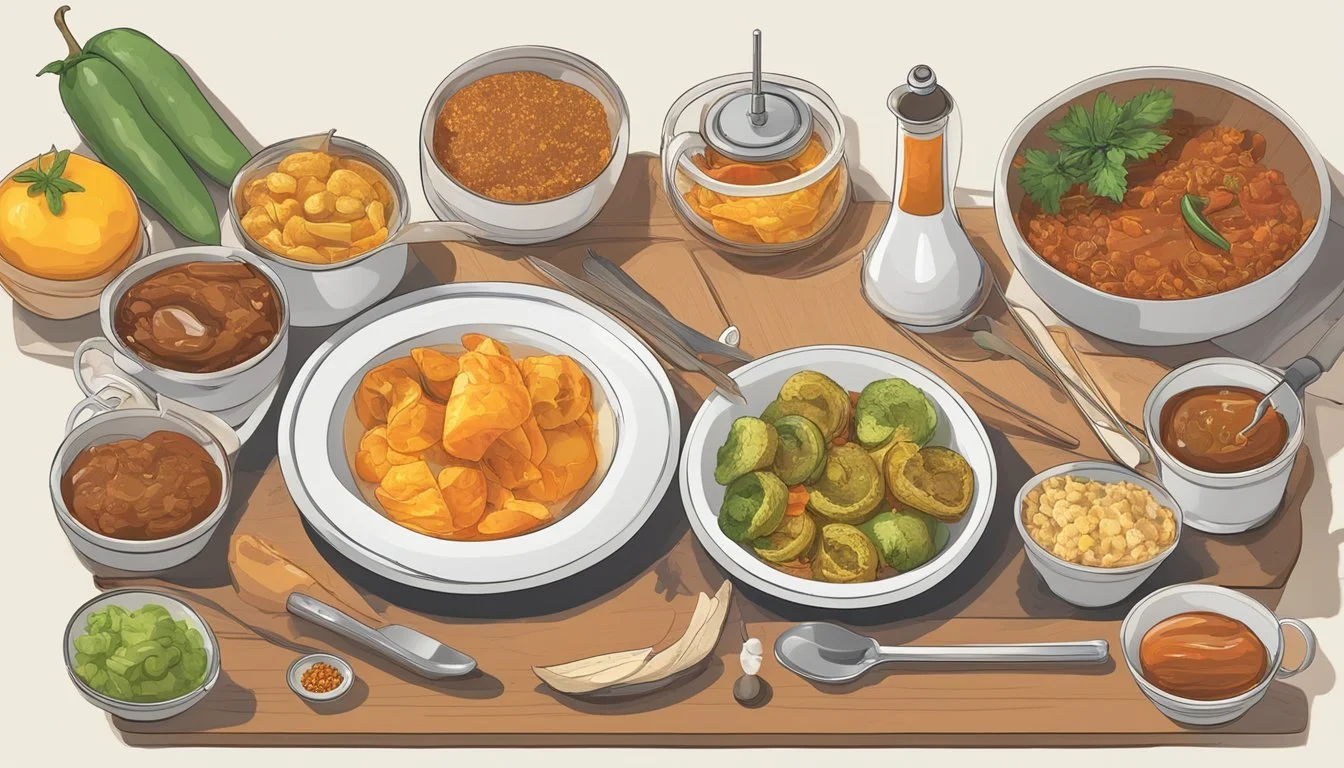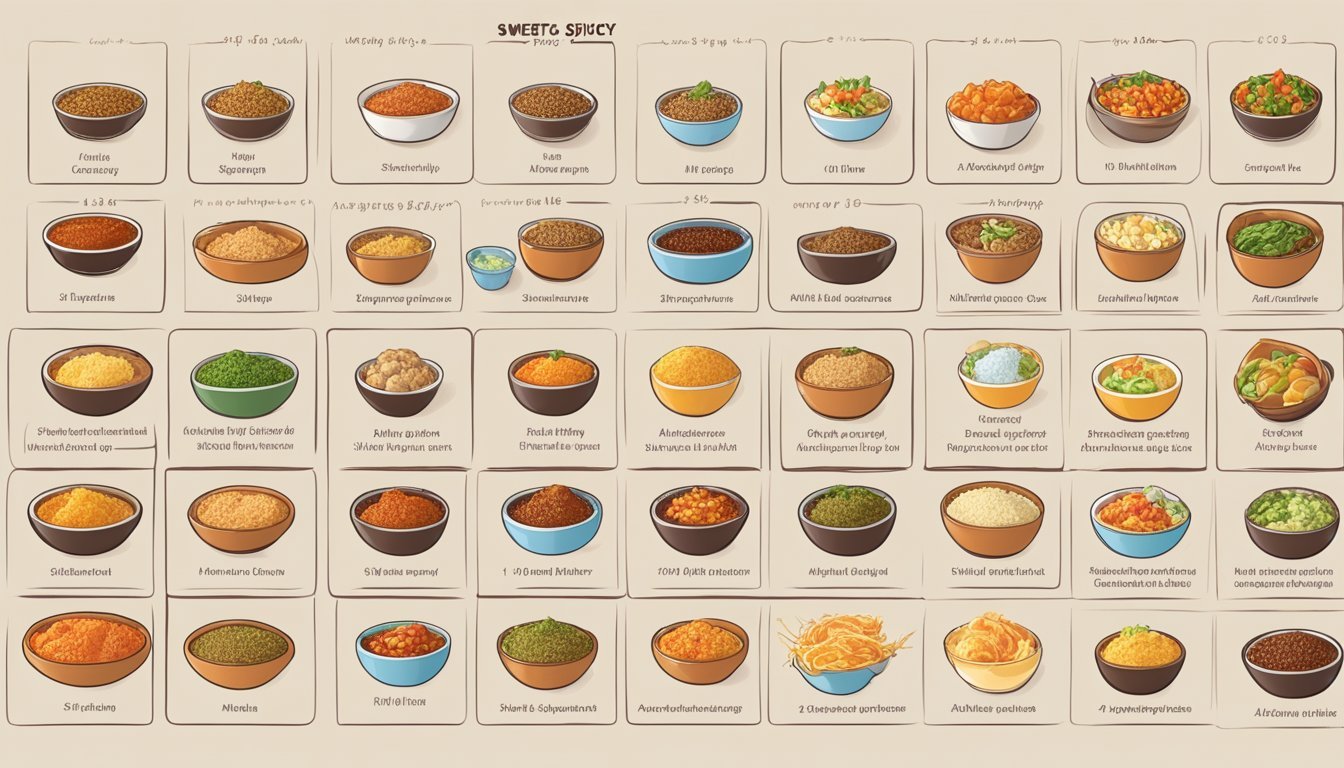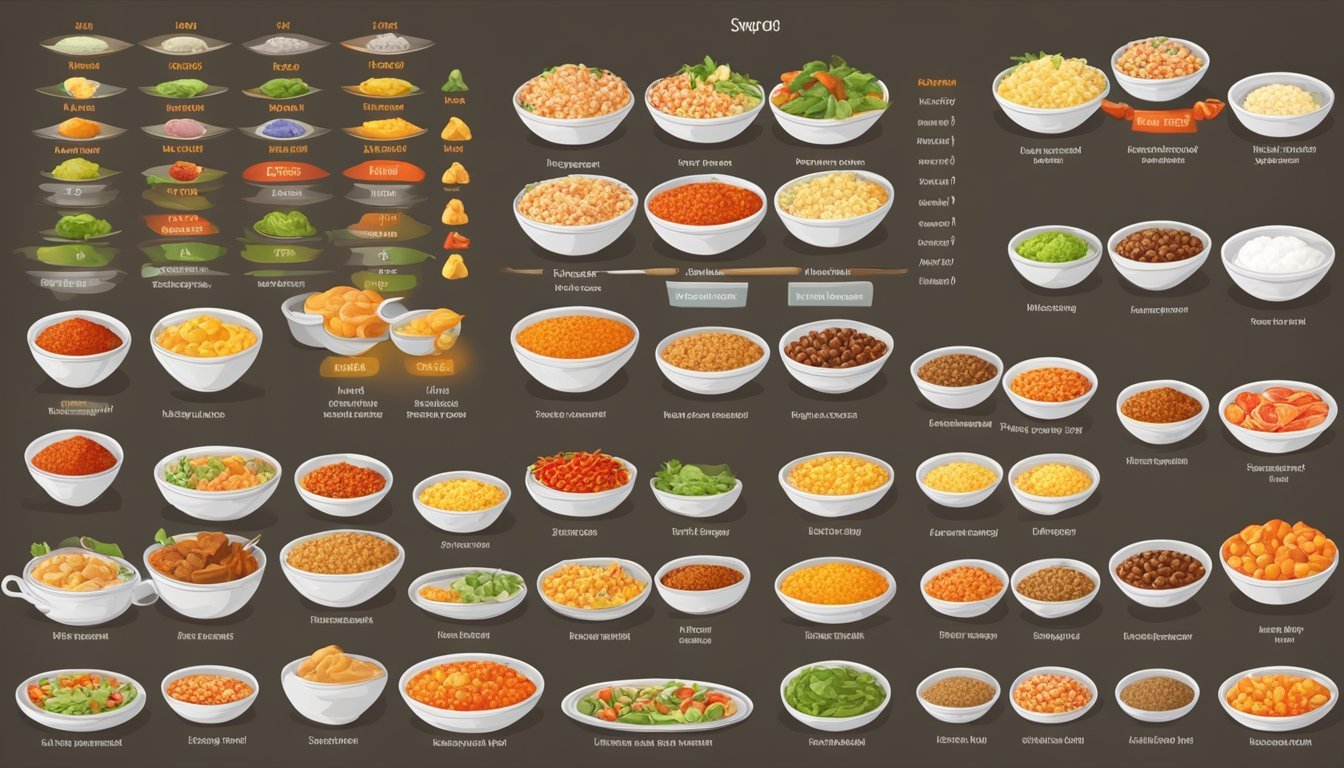The Swicy Scale
Evaluating Popular Sweet-Spicy Cuisine Heat Levels
The culinary landscape has recently embraced an exciting trend known as 'swicy,' a portmanteau of sweet and spicy, representing a fusion of flavors that tantalize the palate in a harmonious blend. Swicy dishes are characterized by their ability to incorporate the heat of spices with the subtlety of sweetness, creating a complex and multi-dimensional taste experience. This blend of flavors has become increasingly popular, with its presence on restaurant menus and in packaged foods rising significantly.
To appreciate the swicy trend, it's essential to understand the components that create this distinctive flavor profile. Heat in dishes comes from various spices and peppers, each with its own level of intensity that can be measured on a scale, such as the Scoville Scale for peppers. Similarly, sweetness can come from multiple sources like sugars, syrups, and even fruits, adding a contrasting layer to the heat which can balance and enhance the overall flavor.
The phenomenon has sparked interest in establishing a 'Swicy Scale,' a tool for rating the heat level in popular sweet-spicy dishes. Such a scale would help consumers and chefs alike to gauge the spice level while acknowledging the complementary sweetness that rounds out the culinary experience. It speaks to the evolving tastes and innovation in the food industry, recognizing the artful blend of flavor notes that can elevate a simple meal into a memorable dining event.
Understanding the Swicy Scale
The Swicy Scale is a unique measure that combines the Scoville Heat Units with an assessment of sweetness to rate sweet-spicy dishes (What wine goes well with spicy dishes?), appealing to a broad range of taste preferences.
Origins of Spice Measurement
The concept of measuring the heat in peppers originated with the Scoville Scale, developed in 1912 by Wilbur Scoville. Scoville Heat Units (SHU) were determined by diluting a pepper extract until its heat was no longer detectable by a panel; the degree of dilution gave the measure of heat. This scale is still widely used to rate the spiciness of peppers and sauces.
Sweetness and Heat Interaction
The interaction between sweetness and heat plays a critical role in culinary experiences. Sweetness often balances the intensity of the heat, while heat can enhance the overall flavor profile of a dish. For many, the pleasure of eating sweet and spicy dishes comes from the way sugar can temper the spiciness, creating a moreish synergy on the taste buds.
Swicy Scale: Measuring Sweet-Spicy Balance
The Swicy Scale takes the Scoville rating into account but goes one step further to evaluate the balance between sweet and spicy elements. Where conventional SHUs focus solely on heat, this scale considers how the addition of sweet flavors and ingredients like sugar can mitigate mild heat or elevate the intensity. Research firm Datassential noted a trend of increasing sweet and spicy pairings on menus, indicating that this balance is key to the popularity of "Swicy" dishes. The Swicy Scale, still in its relative infancy, aims to become a standard for rating the nuanced flavors of sweet and spicy creations.
Key Ingredients in Sweet-Spicy Dishes
Sweet-spicy dishes blend the heat of peppers with the mellowness of sugars and fats. This section identifies key ingredients used to create this flavor profile.
Chili Peppers and Varieties
Chili peppers are fundamental for heat in sweet-spicy dishes. The Scoville scale measures their heat level, with common varieties including jalapeños (2,500–8,000 Scoville Heat Units), cayenne (30,000–50,000 SHU), and habanero (100,000–350,000 SHU). Specialty varieties like gochujang, a Korean chili paste, contribute a distinct flavor along with heat.
Popular Chili Peppers:
Jalapeño: Medium heat, versatile in many dishes
Cayenne: Sharp, intense heat suitable for sauces
Habanero: Robust heat, often used in hot sauces
Gochujang: A fermented chili paste adding a unique depth to dishes
Sweetening Agents
Sweet flavors balance the intensity of chili peppers. Sugar, in its many forms like brown sugar, provides caramel notes. Honey, including trend-setting hot honey, adds sweetness with a hint of floral nuances. Fruits such as mango and pear can also introduce natural sweetness to temper hot flavors.
Common Sweetening Agents:
Sugar: White or brown, imparts immediate sweetness
Honey: Offers viscosity and complex flavors, especially when infused with chili
Fruits: Mango and pear purées can bring refreshing sweetness to a dish
Culinary Condiments for Swicy Flavors
Culinary condiments are essential for crafting swicy dishes. Hot sauce blends heat and tang, while chili paste offers thicker consistency and concentrated flavors. Vinegar often plays a role in these condiments, contributing acidity that sharpens both sweet and spicy components.
Key Swicy Condiments:
Hot Sauce: A liquid condiment that can vary widely in flavor and spiciness
Chili Paste: Offers a blend of chili peppers for a prominent kick
Vinegar: Enhances flavors and preserves condiments
The Role of Salts and Fats
Salts and fats, such as salt, cheese, mayo, and milk, not only complement the sweet and spicy flavors but also modulate the heat sensation. Salt can heighten flavors, while fats like cheese and mayo can soften the impact of capsaicin, the compound responsible for chili pepper heat.
Salts and Fats in Swicy Cooking:
Salt: Amplifies the perceived sweetness and heat
Cheese/Mayo: Dairy products help in balancing spice levels with their creamy textures
Milk: Drinking milk is a common remedy to mitigate the burn of spicy foods (What wine goes well with spicy food?)
Scoville Heat Units and the Culinary World
The heat in dishes is quantified using Scoville Heat Units, a measure critical to understanding culinary spiciness. Enthusiasts and chefs rely on the Scoville Scale to balance flavors, particularly in sweet and spicy ("swicy") dishes where capsaicin's kick is essential.
Gauging Spiciness with SHU
Scoville Heat Units (SHU) serve as the standard for gauging the spiciness of peppers and spicy ingredients. Developed by Wilbur Scoville, SHUs measure the presence of capsaicin, the chemical responsible for the sensation of heat. A bell pepper ranks at 0 SHUs indicating no heat, while the Carolina Reaper peaks over 2 million SHUs, currently holding the title for the world's hottest pepper.
Hot Sauce and Global Scoville Variations
The Scoville Scale's application is extensive across different cuisines, particularly in the realm of hot sauce. Caribbean cuisine, for instance, frequently employs habanero peppers with their fruity flavor and significant heat level. Capsicum chinense species, including the habanero, can vary widely in SHU, showcasing the diversity in heat intensity among hot sauces worldwide.
The Influence on Culinary Trends
Research firm Datassential points to the influence of SHU in defining culinary trends, noting a surge in the popularity of swicy flavors. Chefs incorporate varying heat levels in their dishes to cater to the demand for complex, nuanced flavors, using the Scoville Scale as an essential tool for culinary innovation.
Generational Preferences for Swicy
Preferences for heat in dishes reveal generational trends; Millennials and Gen Z show an increasing predilection for bold, swicy combinations. Through Datassential's research, it's evident that these younger generations appreciate a high Scoville rating in their food, signaling a shift towards more adventurous eating habits in contrast to milder preferences of previous generations.
Regional Sweet-Spicy Dishes
From the fiery kick of gochujang in Korea to the zesty tang of hot sauce in New Mexico, sweet-spicy regional dishes span the globe, showcasing a diverse range of flavors, origins, and Scoville heat units. This section uncovers the most popular regional dishes that artfully balance sweet and spicy elements.
Asian Flavors: Sweet, Heat, and Umami
In Asian cuisine, the harmony of sweet and spicy can be epitomized by Korean gochujang—a fermented chili paste that adds a multi-dimensional flavor to dishes with its unique blend of heat, sweetness, and a touch of umami. Often rated from 1,000 to 10,000 Scoville heat units, it's a staple in dishes like bibimbap and tteokbokki. Similarly, the interplay of flavors like ginger and sweet elements like carrot create a delightful juxtaposition in dishes across the continent.
Sweet-Spicy Fusion in the Americas
The Americas boast a diverse culinary landscape where Tex-Mex cuisine combines bold jalapeño and habanero peppers with sweet corn and tomato for a zesty flavor. The Scoville scale varies widely, with jalapeños ranging from 2,500 to 8,000 units, and habaneros soaring up to 350,000. The influence of sweet-spicy heat can be seen from California to New Mexico, each region adding its own touch with local ingredients.
Indian Spices Meet Sweet Elements
Indian cuisine skillfully marries spices with sweet undertones, where a curry might offer a burst of heat from chili peppers, balanced by the earthy sweetness of spices like cinnamon and cardamom. Heat levels are as diverse as the country's culinary traditions, with some curries climbing the Scoville scale due to their generous use of spices.
Caribbean Tropical Heat
Caribbean dishes often feature a tempting combination of tropical fruits and fiery chili peppers, which provide a sweet heat that's both refreshing and invigorating. The use of fruity, tropical habanero peppers, with their considerable heat measured between 100,000 and 350,000 Scoville heat units, adds a palatable zing to the local dishes, carving out a distinct niche in the sweet-spicy culinary spectrum.
Scaling Heat in Fast Food and Restaurants
The recent trend of incorporating sweet and spicy flavors into menu items is reshaping the fast-food and restaurant landscape. With the rise in popularity of 'swicy' offerings, establishments are strategically using the Scoville scale to rate the heat of peppers in their dishes, catering to a range of consumer heat preferences.
Market Innovations and Swicy Offerings
Fast food giants and restaurants have swiftly adopted the 'swicy' trend, with innovations designed to entice both the heat-loving and sweet-toothed demographics. Outback Steakhouse introduced a "Sweet Heat Season" menu that capitalizes on the sweet-spicy craze, with items featuring hot honey to excite palates. Similarly, Pizza Hut has explored this flavor territory by adding fiery options that challenge the Scoville scale tolerances of their customers.
Chick-fil-A harnessed this trend by incorporating spicy sriracha sauce into their glazes, striking a balance between heat and sweetness.
These innovations are often driven by market research, such as findings by Datassential that noted a 38% increase in such pairings on menus.
Fast Food "Swicy" Scale Example:
Fast Food Chain Swicy Menu Item Heat Level (Scoville Units) Outback Steakhouse Sweet Heat Ribs Moderate (1,000-2,000) Pizza Hut Spicy Honey-Sriracha Pizza Low to Moderate (500-1,500) Chick-fil-A Sriracha Glazed Sandwich Low (500-1,000)
Consumer Demand for Sweet and Spicy Options
The demand for sweet and spicy flavors is particularly pronounced among Millennials and Gen Z, prompting brands like Takis to expand their product lines with new heat levels, and Torani to introduce swicy syrups for beverages. Andrea Ramirez, a noted food researcher, underscores the importance of understanding the shifting consumer flavor profiles, highlighting that Millennials and Gen Z are increasingly seeking adventurous eating experiences with a kick. The key is balancing the distinct flavor of sweetness with the right punch of spice, be it through sauces or seasoning blends, to satisfy this emerging preference.
Home Cooking with the Swicy Scale
The Swicy Scale offers an innovative approach for home chefs to add depth by pairing the sweet with the spicy, tailoring heat in dishes to create a taste that tickles the palate without overwhelming it.
Swicy Recipes for Home Chefs
Home chefs can explore the fusion of sweet and spicy flavors through a wide array of recipes. From the mild heat of a mango-habanero salsa to the tongue-tingling sensation of a honey-sriracha glazed chicken, the key is to start with a base recipe and adjust the sweet and spicy components to taste.
Mango-Habanero Salsa
Sweet: Fresh mango chunks and a hint of honey.
Spicy: Diced habanero peppers, tailored to heat preference.
Honey-Sriracha Glazed Chicken
Sweet: Rich honey to coat and caramelize.
Spicy: A bold amount of sriracha sauce, adjusted for desired heat.
Creating Balanced Sweet-Spicy Marinades
Marinades are the secret weapon for adding flavor and tenderness to proteins. A well-balanced sweet-spicy marinade typically combines acidic components with sweeteners and spice elements to achieve the perfect swicy profile.
Acid: Vinegar or citrus juice—softens the meat fibers.
Sweeteners: Brown sugar or molasses—enhances the caramelization.
Spices: Cayenne or chipotle powder—provides the scale of heat.
Enhancing Everyday Meals
Incorporating swicy elements into everyday meals can transform the mundane into the extraordinary. Chefs can add a swicy twist to pizza by drizzling hot honey over the top, or they can introduce a subtle kick to sandwiches with a sweet chili aioli.
Pizza
Drizzle hot honey for a sweet heat finish.
Sprinkle with crushed red pepper flakes for a mild, spicy touch.
Sandwiches
Spread a sweet chili aioli on the bread.
Include pickled jalapeños for a burst of swicy flavor.
Conclusion
The essence of 'swicy'—a portmanteau of sweet and spicy—dishes lies in the harmony of flavors. They are a testament to the culinary skill of balancing the heat from the spices and the sweetness, which can mitigate the intensity and enhance enjoyment. Consumers have shown an increased appreciation for this flavor profile, reflected in its growing popularity on menus worldwide.
Heat Levels: Categories range from mild to very spicy; individual preferences dictate the ideal heat level.
Sweet Counterbalance: Sugar's role is paramount in softening the spice's edge.
Pairing Ingredients: Certain ingredients are natural partners, helping to perfect that swicy balance.
Recipes that incorporate this flavor combination are not just trendy but are also rooted in the pleasure they provide. The endorphin release triggered by spicy foods, coupled with the comforting nature of sweet flavors, creates an almost addictive culinary experience.
It's important to note that while the swicy trend is intriguing, it's not a one-size-fits-all. Many individuals have different thresholds for heat, and the 'swicy' scale needs to be flexible to accommodate personal preferences. Catering to these taste fluctuations, chefs are continuously innovating to offer a varied swicy spectrum that can delight a wide audience.
Ultimately, swicy dishes represent a culinary niche where the thrill of spice meets the allure of sweetness, capturing the essence of modern fusion cuisine.
References
The rise of the "swicy" flavor profile — a blend of sweet and spicy — has sparked interest among food enthusiasts and culinary experts. This section cites the research and media outlets that provided valuable insights into this trend.
Food Republic detailed how the balance of sugar and spice in swicy condiments creates a harmonious taste. The article emphasized the combination's ability to soften the sharpness of hot dishes and its physiological effect of releasing endorphins.
From TODAY, their coverage included statistics from Datassential, showing a 38% increase in sweet and spicy pairings on menus, highlighting the popularity of hot honey as an emerging flavor.
Datassential research was mentioned in multiple sources, with a focus on the expansion of sweet-spicy menu options by 38% over the past year, underscoring the significant growth of the swicy trend in the food industry.
Kalsec Market Research provides data supporting that three-quarters of consumers prefer a certain level of heat in their food, marking a 15% rise from 2019. This data was instrumental in understanding consumer preferences towards spicy flavors in both savory and sweet sectors, including patisserie and chocolate.
The mentioned references have contributed to the analysis and understanding of the swicy trend. They served as key sources for assessing the impact of sweet and spicy combinations on current culinary developments.
Acknowledgments
In the compilation of The Swicy Scale article, contributions from various culinary experts, researchers, and gastronomy enthusiasts were paramount. A particular recognition is extended to the teams at Datassential for their trend-tracking analytics which illuminated the rise in 'swicy'—the portmanteau for sweet and spicy—cuisine.
The authors also extend their gratitude to Food Republic and other culinary publication contributors for their detailed exploration of the Scoville Scale. Their efforts in tasting and testing have been invaluable in establishing a systematic approach to measuring spice levels in sweet-spicy dishes.
Special acknowledgment goes to the legacy of Wilbur Scoville, whose development of the Scoville Scale has provided a foundational framework for this article. Without his method for gauging capsaicin's heat, the ability to rate 'swicy' foods with precision would be compromised.
List of key contributors:
Datassential
Food Republic
Wilbur Scoville
Gastronomic institutions specializing in capsaicin research
Areas of assistance:
Data Analytics on Menu Trends
Scale Development Methodologies
Culinary Testing and Assessment
This section intends to convey sincere appreciation for the collective knowledge and resources that have been shared, which shape a deeper understanding of the intersection between sweetness and spiciness in modern cuisine.


